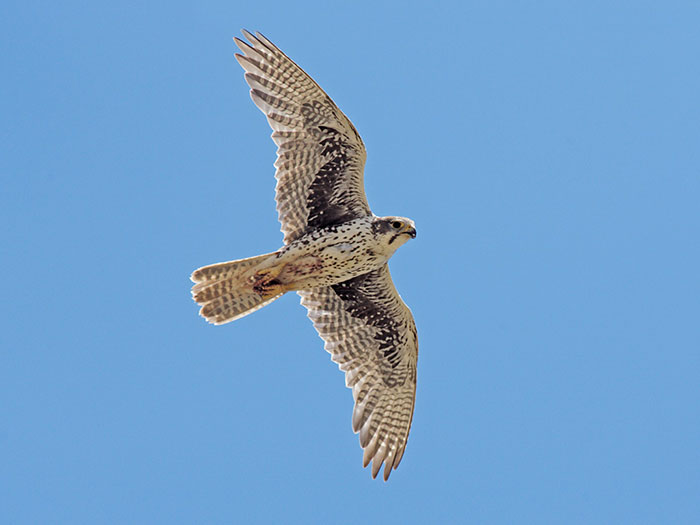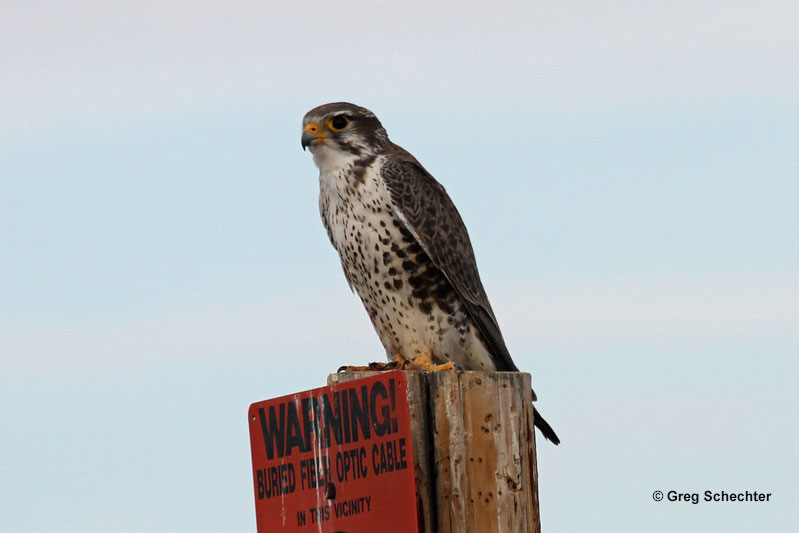Prairie Falcon (Falco mexicanus) is a crow-sized bird of prey with long, pointed wings, and a long, pale brown tail. They are pale brown above and have fine brown streaks on white underparts.
A pale, slim raptor flying low and fast over rangelands and other wide-open habitats is probably this species. Prairie Falcons can also be seen perched high on the cliffs and bluffs that they use for nesting.
Have you wondered how to tell a Prairie Falcon from the Peregrine Falcon? Learn all about this desert raptor in this article
On this page
Identification
The Prairie Falcon is a slim, pale falcon around the same size as a crow. On average, these birds of prey are 16 inches long, have a 40-inch wingspan, and weigh 1.6 pounds. If you see two Prairie Falcons together, one will look larger than the other bird.
This is because, like other falcon species, female Prairie Falcons are a little bit bigger than males. Other than size, both sexes of adult birds look the same.
These birds of prey are pale brown above, and have some small, fine brown markings on their white underparts. They also have pale barring on their long, pale brown tails.
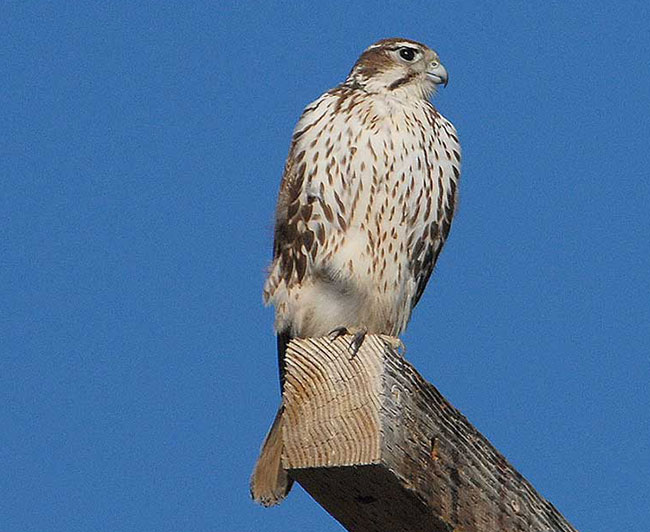
Photograph © USFWS
On the Prairie Falcon’s blocky head, we can see a brown mustache mark, some white behind their eyes and on their face, and a narrow white eyebrow. When perched, their long wings almost reach the end of their tail.
Young birds resemble adults but are darker brown above and have dark brown streaks below. No matter what their age, Prairie Falcons have quick and direct flight, often low over the ground. When flying, we can see blackish markings on their underwings and where their wings meet their body.
Vocalization
This species makes repeated, loud, raspy calls, “reh reh reh reh reh reh reh reh reh”.
Food
Prairie Falcons feed on a variety of small mammals and small to medium-sized birds. In many places, they catch a lot of Thirteen-lined Ground-Squirrels and other ground-squirrel species but can also catch Pikas and other small rodents.
This bird of prey eats various types of birds, including Western Meadowlarks, Horned Larks, Mourning Doves, Rock Pigeons, and many other species. In high elevations, rosy-finches can make up an important part of their diet, and they also catch swallows, swifts, and shorebirds.
Prairie Falcons hunt their prey in a few different ways. They can wait on a cliff, telephone pole, or other perch or soar high above to watch for prey.
When they spot a squirrel or bird, they dive down and then fly fast to try and catch the small animal by surprise. They catch most of their prey on the ground but can also catch birds in flight when they need to.
Another way this falcon species attacks prey is by using ground cover to sneak up on animals. It flies fast, just above the ground, and hopes to see prey and catch it before the small animal notices the falcon.
They tend to eat more rodents during nesting season and more birds at other times of the year.
Nesting and Eggs
Prairie Falcons establish breeding territories in early spring. These raptors usually pick a cliff or bluff but can also nest on power line structures, in trees, in caves, on buildings, and on rocky outcroppings.
No matter where they decide to nest, Prairie Falcons use a crevice or other spot that provides shelter from sun, wind, and rain. They don’t really build a nest but, before laying, the mother falcon scrapes together bits of debris to keep the eggs in place.
If she uses an old nest of a raven or other big bird, she just lays her eggs directly in the nest.
The mother bird lays 2 to 6, pale pink or reddish-brown eggs with brown spots. On average, they are two inches long and weigh 1.32 ounces each. The female Prairie Falcon does most of the incubation duties but the male also helps out a little bit.
After 29 to 33 days, the eggs hatch and both parents bring prey directly to their babies for the first three weeks. However, by the fourth week, they leave food at the nest and the nestling falcons feed themselves.
The young falcons leave the nest 30 days after hatching. They continue to be fed by their parents until becoming independent 30 to 35 days after leaving the nest.
Current Situation
The Prairie Falcon is a fairly common raptor that lives in shrubby plains and other open, arid habitats. It breeds in parts of southwestern Canada, and in much of the western USA south to north-central Mexico. In winter, we also see Prairie Falcons in open habitats on the Pacific coast and in the Great Plains east to Missouri and Texas.
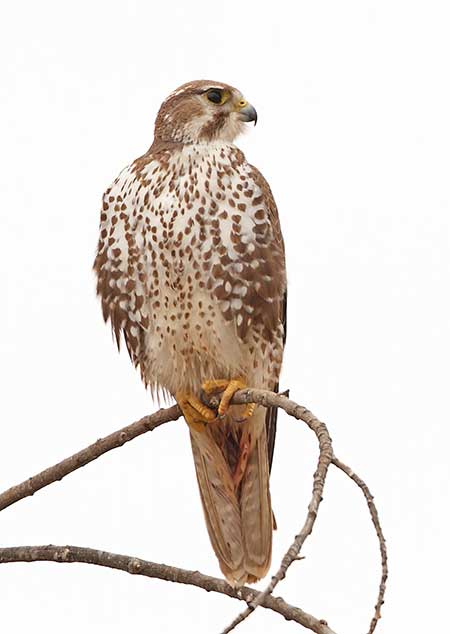
This species is listed as Least Concern in the IUCN Red List and is fairly common throughout its range.
Prairie Falcons are believed to have a large and stable population that may be increasing. Although some individuals are shot or die when they fly into low wires, this species is not considered to be threatened.
This species doesn’t do well in areas with large-scale, intense agriculture that reduce ground-squirrels and other prey animals. However, it is doing well in most of its range. Small farms with several crops, canals, and pasture might even help it.
Related: What do falcons symbolize?
Facts
- Like the related Peregrine Falcon, Prairie Falcons are also affected by DDT and other pesticides. However, unlike the Peregrine, they did not suffer serious decline caused by DDT. Prairie Falcons didn’t ingest much of this chemical because they tend to eat more mammals than birds.
- 19 different states allow falconers to take young Prairie Falcons from nests. This does not seem to have an effect on their populations, and the young birds are trained for falconry.
- Courtship and picking a nesting site can last for a month. During courtship, male Prairie Falcons do acrobatic flights and call over different nesting areas until the female picks one of the spots for her nest.
- In direct flight, Prairie Falcons might fly as fast as a Peregrine Falcon. However, unlike the Peregrine, they don’t do steep dives to catch their prey, and thus don’t reach high speeds.
- After baby Prairie Falcons leave the nest, they can’t fly as well as their parents. Since they can’t catch rodents and small birds, they hunt on the ground for lizards and insects that live on rocky slopes near their nest.
Similar Species
The Prairie Falcon is a distinctive raptor. However, it does share some characteristics with a few other species.
Peregrine Falcon
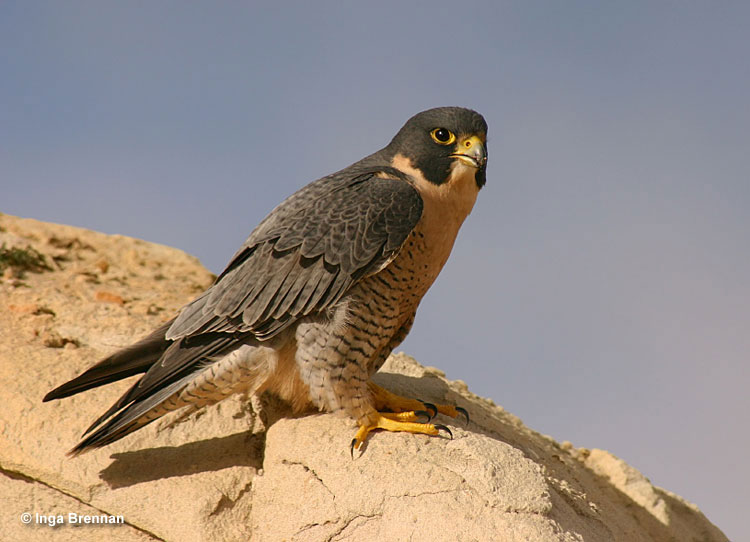
The famous Peregrine Falcon is the same size as the Prairie Falcon. Occasionally, they are also seen in the same places. Adult Peregrine Falcons are easily separated from Prairie Falcons by their dark gray backs and black on their heads.
Young Peregrines can look a lot like a Prairie Falcon, but the Prairie is always paler brown, has a paler, plainer tail, and has black-brown on its flanks and underwings.
Gyrfalcon
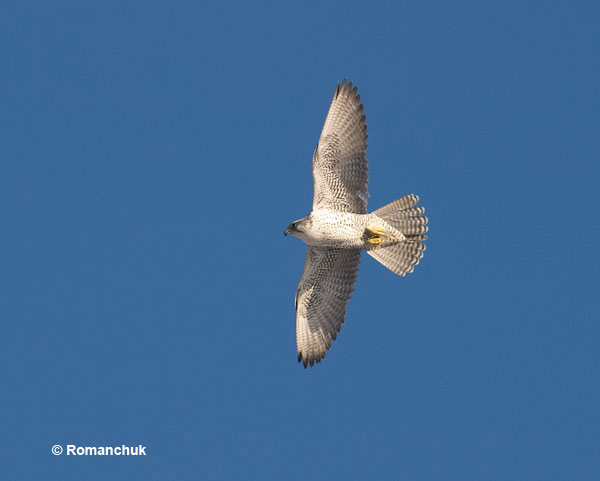
On rare occasions, wintering Gyrfalcons can be found in some of the same places where Prairie Falcons occur. However, Prairies are always much smaller (more the size of a small crow), have white on their face, are paler brown, and have black-brown on their flanks and underwings.
Merlin
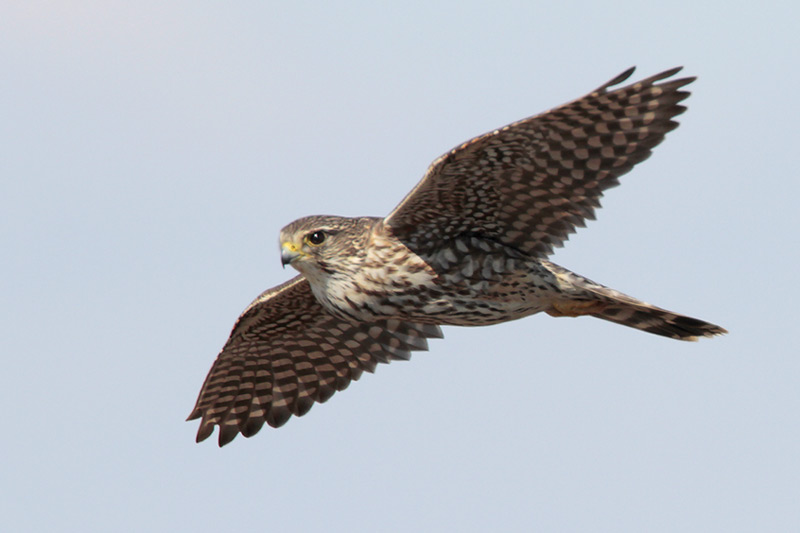
Sometimes, female Merlins are confused with the Prairie Falcon. However, Merlins are much smaller, have prominent bands on their tail, and lack black marks on their underwings. Prairie Falcons also have a more prominent moustache mark.
Frequently Asked Questions
Is a Prairie Falcon a raptor?
Yes, a Prairie Falcon is a raptor. All falcons are considered to be raptors.
Where are Prairie Falcons found?
Prairie Falcon are found in open, arid habitats in parts of southern British Columbia and Alberta. They are also found in much of the western USA east to Missouri and south to northern Mexico.
What is the difference between a Prairie Falcon and a Peregrine Falcon?
The difference between a Prairie Falcon and a Peregrine Falcon is that the Prairie Falcon is much paler, and has dark markings on its flanks and under its wings.
Are Prairie Falcons aggressive?
Yes, Prairie Falcons are aggressive when defending their nests. They fly at eagles and other large birds and mammals that approach too close.

